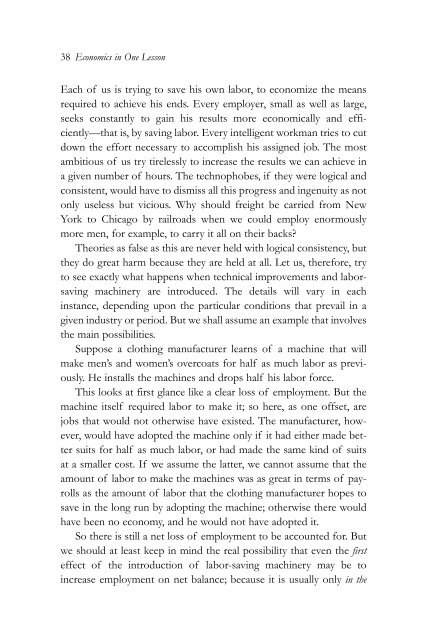1gDdM7w
1gDdM7w
1gDdM7w
- No tags were found...
Create successful ePaper yourself
Turn your PDF publications into a flip-book with our unique Google optimized e-Paper software.
38 Economics in One LessonEach of us is trying to save his own labor, to economize the meansrequired to achieve his ends. Every employer, small as well as large,seeks constantly to gain his results more economically and efficiently—thatis, by saving labor. Every intelligent workman tries to cutdown the effort necessary to accomplish his assigned job. The mostambitious of us try tirelessly to increase the results we can achieve ina given number of hours. The technophobes, if they were logical andconsistent, would have to dismiss all this progress and ingenuity as notonly useless but vicious. Why should freight be carried from NewYork to Chicago by railroads when we could employ enormouslymore men, for example, to carry it all on their backs?Theories as false as this are never held with logical consistency, butthey do great harm because they are held at all. Let us, therefore, tryto see exactly what happens when technical improvements and laborsavingmachinery are introduced. The details will vary in eachinstance, depending upon the particular conditions that prevail in agiven industry or period. But we shall assume an example that involvesthe main possibilities.Suppose a clothing manufacturer learns of a machine that willmake men’s and women’s overcoats for half as much labor as previously.He installs the machines and drops half his labor force.This looks at first glance like a clear loss of employment. But themachine itself required labor to make it; so here, as one offset, arejobs that would not otherwise have existed. The manufacturer, however,would have adopted the machine only if it had either made bettersuits for half as much labor, or had made the same kind of suitsat a smaller cost. If we assume the latter, we cannot assume that theamount of labor to make the machines was as great in terms of payrollsas the amount of labor that the clothing manufacturer hopes tosave in the long run by adopting the machine; otherwise there wouldhave been no economy, and he would not have adopted it.So there is still a net loss of employment to be accounted for. Butwe should at least keep in mind the real possibility that even the firsteffect of the introduction of labor-saving machinery may be toincrease employment on net balance; because it is usually only in the


